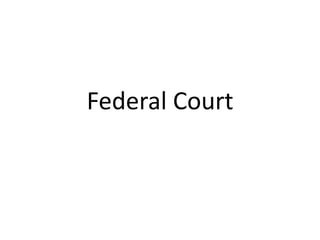
Federal court
- 2. Public Opinion and early up to 1935 Sir Hari Singh Gour was the first in the legal history of India, who realized the necessity of establishing and all Indian court of final appeal in India in place of the Privy Council. So many times he moved resolutions in the Central Legislature Assembly between 1921-1925 regarding establishment of a Court of Ultimate Appeals in India. While introducing the resolutions, Sir Hari Singh Gour laid special emphasis on four important points.
- 3. 1. the Judicial Committee of the Privy Council was not a tribunal or a Court, it was just an advisory body constituted and intended to advise the King. 2. The expenditure of an appeal to the Privy Council was too expensive. 3. The distance from India of the Privy Council resulted in unnecessary delay ( four to five years in many cases). 4. Since Canada, Australia and South Africa had such a tribunal there was no Supreme Court of our own in this country.
- 4. During the period 1931-32 i.e. between the Second and third session of the Round Table Conference, the Central Legislature also passed a resolution for the establishment of Supreme Count India. The joint Select Committee of both Houses of Parliament in its report in November, 1934 recommended to establish a Federal Court in India.
- 5. Foundation of the Federal Court The Government Act, 1935 changed the structure of the Indian Government from “Unitary” to that of the “ Federal type” in India. The Act established the foundation for the Federal framework in India. A Federal Constitution, it must be noted, involves a distribution of powers between the Centre and the component units. Section 200 of the Act provided for the establishment of a Federal Court in India.
- 6. for appointment of a Judges in Federal Court, the Chief Justice and not more then six judges, who were to be appointed by the King. • On 1st October, 1937, the Federal Court was inaugurated at Delhi. Three judges were appointed in the Court of namely, • Sir Maurice Gwyer (who had association with preparation of 1935 Act) • Sir Shah Muhammad Sulaiman (He was the Justice of Allahabad High Court) • Mukund Ramrao Hayakar (Leading Advocate of Bombay)
- 7. Appointment of the judges was purely based on the discretion of King. The Judges, they could hold their office till the age of 65 years. Qualifications: for judges Five years experience s Judge of a High Court, or A barrister or an advocate of ten year’ standing or A pleader in High Court of ten years’ standing For Chief justice 15 years experience of standing in a High Court as a barrister, advocate or pleader.
- 8. • Salaries: the Federal Court Order in council of 1937 fixed the salary of the Chief Justice at Rs. 7000 a month and other judges at Rs. 5000 a month. Jurisdiction of the Federal Court Under the Government of India Act, the Federal Court was given three kinds of jurisdictions namely: 1. Original Jurisdiction 2. Appellate Jurisdiction 3. Advisory Jurisdiction Section of 206 of the Federal Legislature to pass an Act enlarging the Appellate jurisdiction of the Federal Court in civil cases to its full extent.
- 9. Original jurisdiction Section 204 of the Act of 1935 provided that the original jurisdiction of the Federal Court was confined to disputes between Units of the Dominion or between the Dominion and unites. The Federal Court had no powers to certain suits brought by private individuals against the Dominion. Section 208 provided for a right of appeal to the Privy Council from the judgments of the Federal Court in the exercise of its original jurisdiction.
- 10. Appellate Jurisdiction The Federal Court exercised appellate jurisdiction in constitutional cases under the Act of 1935, its appellate jurisdiction was extended to civil and criminal cases from 1948. No appeal was allowed to the Federal Court in the absence of a certificate from British Indian High Courts or State High Courts. Advisory Jurisdiction: Section 213 of the Act of 1935 empowered the Federal Court to give advisory opinion to the Governor General. Governor General was not to bound to accept the opinion of the Federal Court which was given under section of 213.
- 11. Authority of Law laid down by Federal Court: Section 213 of the Government of India Act, 1935 provided that the law declare by the Federal Court and any judgment of the Privy Council will be binding on all the Courts in British India. It introduced the English Doctrine of precedent in India